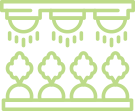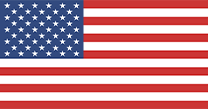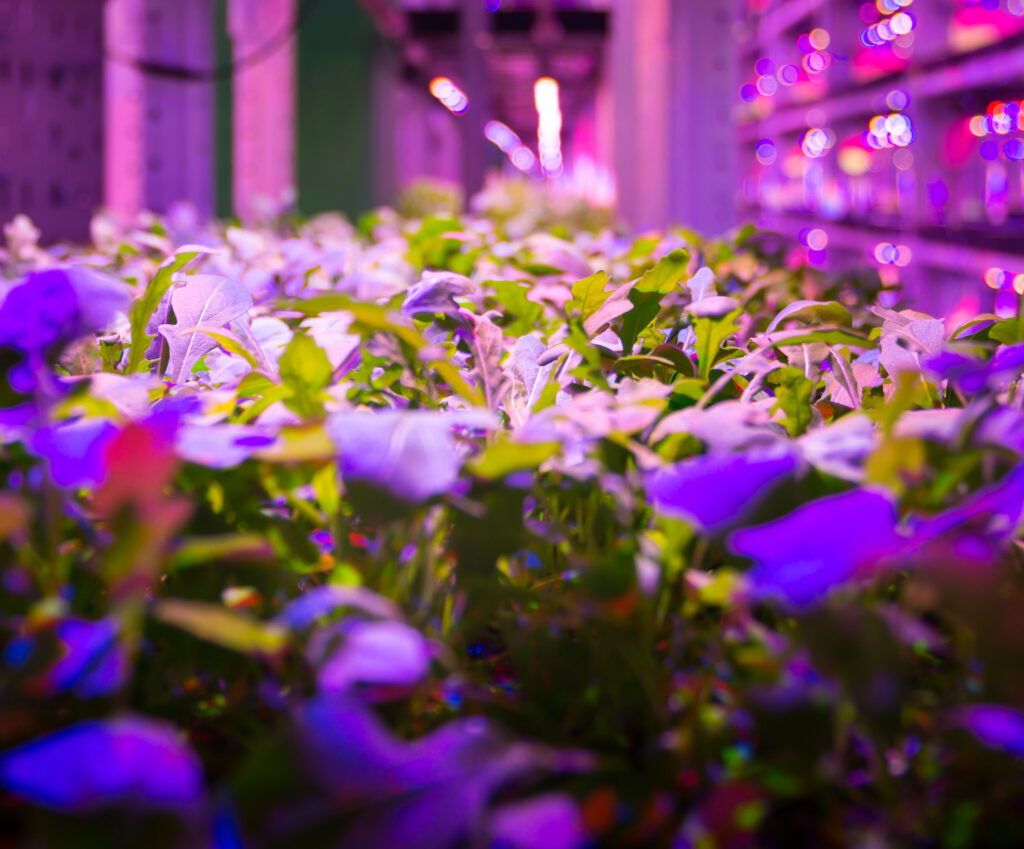
November 28, 2023
The Significance and Often Overlooked Impact of Far-Red Photons on Plant Growth
In the realm of horticultural lighting, a groundbreaking revelation is taking root. The application of far-red light, a segment of the electromagnetic spectrum barely visible to the human eye, is emerging as a pivotal factor in enhancing plant growth and morphology. This innovative approach of providing far-red in the grow spectrum, explored by engineers at JumpLights and various laboratories, paves the way for the largely overlooked potential of far-red photons. In this article, we delve into the recent findings and commercial implications of far-red light application in controlled environment agriculture.
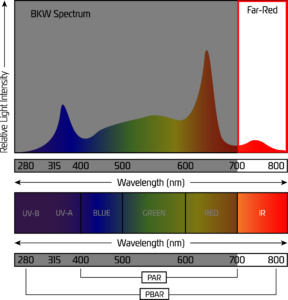
Far-Red Light Canopy Penetration
Far-red light refers to electromagnetic radiation with wavelengths longer than those of visible red light, typically in the range of 700 to about 750 nanometers. Longer wavelengths are infra-red Light, and shorter wavelengths are part of the visible light spectrum.
Far-red light possesses a noteworthy characteristic: in contrast to shorter visible wavelengths, it has the ability to penetrate more deeply into the canopy. This is evident in the graph below, which illustrates light intensity in both moderate and deep foliar shade conditions. The enhanced penetration of far-red light through plant canopy and leaf tissue compared to visible light has prompted scientists to investigate its role in photosynthesis and photomorphogenesis.
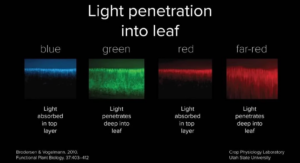
The Emergence of Far-Red Photon Research
Going deeper into the foliar shade (canopy) the red to far-red ratio decreases, and this leads to the well studied shade-avoidance responses—such as stem elongation, leaf expansion and early flowering [2]. This has been demonstrated in many studies to date, but until recently far-red light could not be isolated by itself in natural light studies or in artificial lighting studies. For years, the singular effects of far-red light on plants remained elusive, primarily due to its absence in traditional electric lights. The advent of efficient far-red LEDs, however, has opened up new possibilities, prompting scientists to reconsider the role of these overlooked wavelengths in plant biology.
Far-Red Effect on Plant Growth and The Emerson Effect
By isolating the generation of far-red light from other wavelengths, researchers are now able to conduct experiments to observe its impact when added to other light wavelengths. What they found has been coined “The Emerson Effect.” Named after scientist Robert Emerson, the Emerson Effect is a phenomenon where the combined exposure to red and far-red light enhances photosynthesis beyond what each wavelength achieves independently. This is not just academic; it’s a tool that can be wielded for tangible benefits in cultivation. An illustrative study conducted at Utah State University focused on the influence of far-red light on the biomass production of lettuce. The experiment utilized four growth chambers, conducting parallel treatments where far-red light was incorporated into both white light and red-blue light, while maintaining consistent total light levels measured by photon flux. Intriguingly, in both color spectrums, the chambers receiving additional far-red photons exhibited superior growth compared to those without [3].
Far-Red Interactions
The preceding study demonstrated that far-red light can impact growth, however, treatment of far-red is not straightforward. Depending on the colors and intensities of other wavelengths applied, the effects of far-red can vary. The interaction with low or high blue light intensity has been extensively studied. In response to previous findings of elongation with high far-red, researchers at Michigan State University explored whether incorporating high blue light intensity, known for enhancing compactness, could counteract this effect. Their aim was to determine if a moderately high intensity of blue light could mitigate the promoting effects of far-red on stem elongation without hindering flowering. The researchers confirmed their hypothesis, showing that the addition of blue light could suppress the elongation-promoting effects of far red while minimally affecting flowering. Furthermore, the inclusion of blue light independently increased leaf chlorophyll concentration, resulting in slightly darker green leaves and they concluded that incorporating far-red light with a moderately high intensity of blue light in an LED spectrum can stimulate flowering in some long-day plants while maintaining compact plants with greener leaves [4].
Conclusions
The ability to provide far-red light using efficient, cutting-edge LEDs has expanded the toolbox of available spectrum-tuning options that growers have to influence plant characteristics. Most importantly, when combined with other spectral qualities, far-red light has the ability to affect compactness, seedling health, and subsequent flowering. Please contact your JumpLights sales engineer for information on how to optimize LED lighting for your crop and your ideal growing conditions.
References:
[1] Dominic Petrella, “Out of the shadows: Using data to breed better turfgrasses for shade” University of Minnesota 2/3/2020. https://turf.umn.edu/news/out-shadows-using-data-breed-better-turfgrasses-shade
[2] Yujin Park & Erik Runkle, “LEDs: Blue & Far-Red Light” GrowerTalks 4/1/2019. https://www.growertalks.com/Article/?srch=1&articleID=24088
[3] Bruce Bugbee, “Far-red: The Forgotten Photons” 10/29/2019. [Video]. https://youtu.be/sS7aAcacfgk?si=3y0JuFpJroP7muqG
[4] Mengzi Zhang,Yujin Park & Erik Runkle, “A Little Far-Red Light Goes a Long Way” GrowerTalks 5/1/2019. https://www.growertalks.com/Article/?articleid=24146
